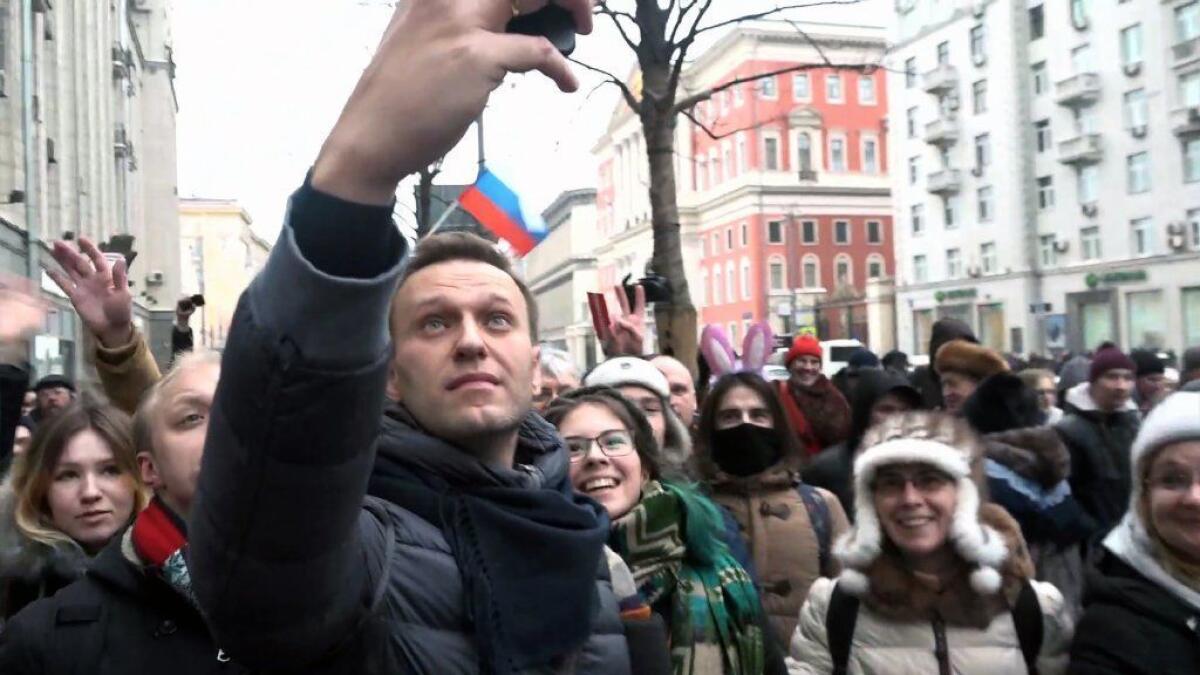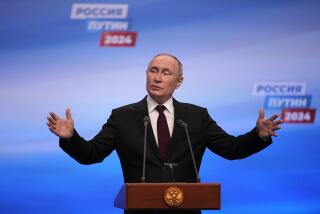‘Come arrest me,’ Russian opposition leader taunted. So police in Moscow did just that

- Share via
Reporting from Moscow — Hours before a mass anti-Kremlin rally was to begin here Sunday, Russian opposition leader Alexei Navalny appeared in a live-streamed video to assure his followers that he had a cunning plan to avoid arrest.
Because his building in central Moscow was surrounded by police, Navalny said, he had moved to another apartment in Russia’s capital. He then gave the address: Zelinsky Street 6, Apartment 84. A prominent Russian newspaper last year reported that the address was used by Russian President Vladimir Putin for his official registration.
“I’m waiting for all you policemen here,” Navalny, 41, said as he assured his hundreds of thousands of YouTube channel followers with a smirk. “Come arrest me.”
Hours later, they did. Putin’s most prominent political opponent was briefly detained after being arrested — not at Putin’s registration address, but as he made his way toward the demonstrations on Tverskaya Street, the famous central boulevard that ends at the red brick walls of the Kremlin. Within seconds of his arrest, video of officers wrestling him into a police bus along with a few of his supporters was posted online.
From the police bus, Navalny posted to his Twitter account: “I was detained. It doesn’t matter. Come out to Tverskaya. Don’t go for me, but for yourself and your future.”
Navalny called for Sunday’s rallies to support a nationwide boycott of what he calls a rigged presidential election.
The anti-corruption crusader turned presidential hopeful organized protests against the Kremlin government across Russia in March, June and October. Police have arrested him each time for orchestrating unsanctioned rallies.
The demonstrations have seen hundreds of young protesters detained in cities across the country. Demonstrations in June saw the highest number of detentions as police arrested more than 1,000 people.
Though Navalny has gathered enough signatures to support his registration as a candidate in the March 18 election, Russia’s Central Election Commission has barred him from running because of a conviction in a 2013 embezzlement case. Navalny has said the case against him was politically motivated.
The Kremlin insists that Russian elections are free and fair, but in reality Putin’s system of “managed democracy” prevents most opposition candidates from running. Putin’s image shepherding daily events dominates the state-run media, which largely ignore candidates opposing the Kremlin.
Navalny’s popularity has grown as his campaign stretches across Russia’s 11 time zones, particularly with a young generation that follows his YouTube channel and social media accounts while ignoring the government-controlled television news. Video investigations by Navalny’s Anti-Corruption Foundation have exposed what his campaign claims are Kremlin-linked corruption schemes. The most popular investigation into Prime Minister Dmitry Medvedev, which claims the prime minister embezzled about $1.2 billion, has been viewed more than 26 million times.
Putin does not mention Navalny’s name in public. Police have embarked on a harassment campaign against Navalny’s regional campaign headquarters through raids and detentions of local volunteers who are organizing protests and meetings in support of Navalny’s election bid. Parents of young participants in Navalny events have been threatened with firings at work, and students who have attended his rallies have been expelled from government universities.
Sunday’s protests again saw thousands of young Russians coming out to support Navalny’s election day “voters’ strike,” in which voters are urged to come to the polls but mark their ballots without voting for Putin.
Putin has been either prime minister or president since 1999. If he wins March 18 as widely expected, it will be the 65-year-old Kremlin leader’s fourth presidential term. Putin’s approval ratings have hovered around 80% since 2014, when Russia illegally annexed Crimea from Ukraine. The move was seen by Putin’s supporters as a huge win for returning Russia to its former glory, despite the international criticism and Western sanctions that followed.
A successful voters’ strike could be significant if it shows high turnout but diminished support for Putin. Russian media have reported widely that the Kremlin is hoping for a “70/70” at the polls this year, meaning 70% turnout with 70% support for Putin’s reelection.
Sunday’s protests started in Russia’s Far East and Siberia and continued across up to 100 towns and cities. Police reported that nearly 1,000 turned out in both Moscow and St. Petersburg. At each rally, protesters shouted, “Russia without Putin,” and held signs that read “Putin is the thief!” and “Down with the czar!”
In the Siberian town of Yakutsk, demonstrators braved temperatures of minus 49 degrees. There were also protests in remote cities such as Murmansk near the Arctic Circle and the eastern port city of Vladivostok, where an estimated 800 people turned out.
“I came out not because I support Navalny or don’t support Navalny, but because I want to live in a country where I can believe in the results of our elections,” said Alla Naumcheva, a 29-year old finance worker from Moscow. “I’m going to vote, but I’m not going to vote for anyone, I’ll just mark my ballot with some curse words.”
Police on Sunday raided Navalny’s Anti-Corruption Foundation office, where his team was doing live, online video broadcasts. Social media posts showed police using a grinder saw to cut down the door of the studio during the broadcast.
“They are sawing the doors of the federal headquarters right now,” Navalny tweeted, with a photo of the drama.
Once inside, the police detained one of the show’s hosts, Dmitry Nizovtsev, who they said was accused of trying to plant a bomb in the office. After entering the office, police seized computers and cameras, Navalny’s staff reported.
Meanwhile, other members of Navalny’s team were using another studio at an undisclosed location to continue the live-streamed broadcast and avoid detention.
Navalny was released without charges late Sunday night on condition that he appear in court at a later date, his lawyer Olga Mikhailova told Interfax news agency.
If convicted of organizing an unsanctioned protest, Navalny faces 30 days in jail.
Twitter: @sabraayres
Ayres is a special correspondent.
UPDATES:
1:55 p.m.: This article has been updated with Navalny released pending a court date.
This article was originally posted at 9:45 a.m.
More to Read
Sign up for Essential California
The most important California stories and recommendations in your inbox every morning.
You may occasionally receive promotional content from the Los Angeles Times.














